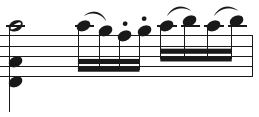The <chord> element
Parent element: <note>

The <chord> element indicates that this note is an additional chord tone with the preceding note.
The <duration> of a <chord> note does not move the musical position within a <measure>. That is done by the <duration> of the first preceding note without a <chord> element. Thus the <duration> of a <chord> note cannot be longer than the preceding note.
In most cases the <duration> will be the same as the preceding note. However it can be shorter in situations such as multiple stops for string instruments. Here is an example from Mozart's Concerto No. 3 for Violin, K. 216:
If these first three notes are represented as a chord, the quarter notes must be the ones with the <chord> element.
Content
Always empty.
Attributes
None.
Examples
This element is used in the following examples: